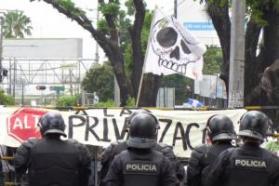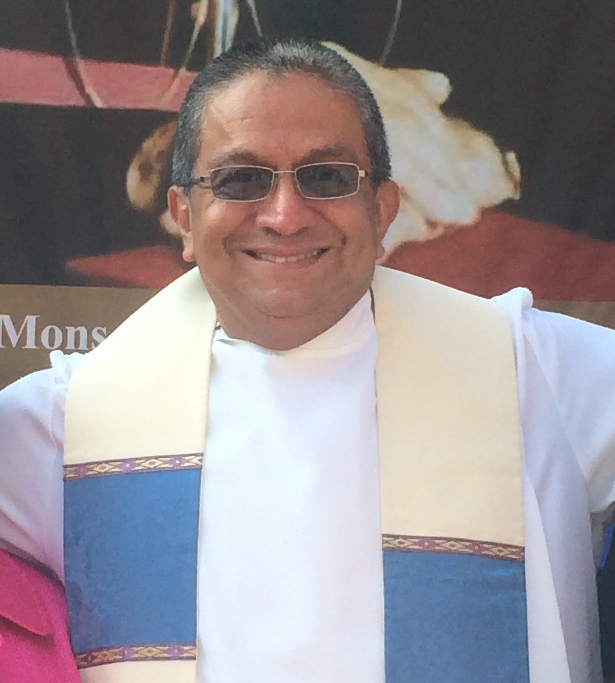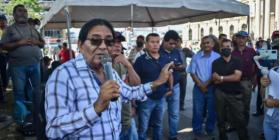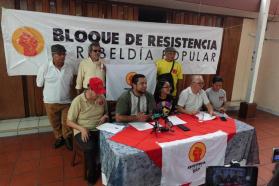The Long Road to Justice: Survivors of the Massacre at El Mozote Continue the Fight
From the Spring 2018 issue of El Salvador Watch
The past few months have seen a number of milestones in the case of El Mozote, the most infamous massacre of civilians from the dark days of El Salvador’s civil war. Long a priority for human rights defenders, the case was re-opened last year with the goal of finally getting some measure of justice and closure for the survivors and families of the victims.
Following the Salvadoran Supreme Court’s July 2016 decision to overturn the Amnesty Law, which the right-wing pushed through the legislature in 1993 to prohibit prosecution of any war-related crimes, a judge in San Francisco Gotera, Morazán, has re-opened the domestic criminal case regarding the massacre of El Mozote. For the first time in history, victims of have been able to testify in a Salvadoran Court regarding what happened. This is also the first time high-ranking members of the Salvadoran military have been charged as the intellectual authors. David Morales, long-time human rights defender and lawyer for the victims, noted “El Mozote is one of the most well-evidenced cases in Salvadoran history, which is one of the reasons why it is such an important test case for our judicial system.”
By 1981, the Salvadoran military was engaged in a full-scale counter-insurgency war against the guerrilla forces organized under the banner of the Farabundo Martí National Liberation Front (FMLN). Backed by the U.S. government, with money, weapons and advisors, the Salvadoran military tried desperately to destroy the popular insurgency. A major part of the strategy, transplanted from the U.S. experience in Vietnam, was the counterinsurgency doctrine, which aimed to defeat the guerrilla by removing all of their support networks. The Salvadoran military to brutally murder tens of thousands of civilians in an effort to destroy support for the democratic liberation movement.
The massacre at El Mozote was part and parcel of this strategy. On December 10, 1981, the elite Atlacatl Battalion arrived in the village of El Mozote in the northern department of Morazán. Over the course of two days, the military proceeded to massacre nearly 1000 people, mostly women and children. The involvement of the United States government in the massacre is hard to understate. The Atlacatl Battalion, created by the U.S. and trained at the School of the Americas, was accompanied throughout much of the war by U.S. personnel.
As news of the massacre reached the public and the international stage after reports by journalists from the Washington Post and the New York Times, the U.S. government flatly refused to acknowledge what had happened. The U.S. Embassy denied the reports and attacked the credibility of the journalists who had broken the story. This reaction was part of the continuous support the U.S. gave to the brutal Salvadoran military as it waged war against its own people.
When the war ended with the 1992 Peace Accords, there was hope that the United Nations-led Truth Commission would lead to justice. At first this appeared to be the case, as the Commission began taking thousands of statements from victims, and a team of forensic examiners from Argentina began exhumations across the country. The Commission reported that a massacre had indeed occurred in El Mozote but the military claimed that no records existed regarding the operation. The final blow was the 1993 Amnesty Law, which closed the door on this and countless other cases.
But the struggle has been given new life. In July 2016 the Constitutional Chamber of the Supreme Court declared the Amnesty Law unconstitutional. While the Salvadoran social movement has widely criticized Constitutional Chamber for many of its rulings, this decision was cause for celebration. As survivor Dorila Marquez, President of the El Mozote Association for the Defense of Human Rights, who lost dozens of family members on that day, said, “We want to keep moving forward; we want justice. We don’t want this to continue into the next generation.”
In 2017, Judge Jorge Alberto Guzmán ordered the criminal case that was first filed in 1991 to be re-opened. Thirty-nine of the survivors of the massacre at El Mozote have since testified, and eighteen high-ranking former officers face criminal charges. Morales notes that “This is the first time in history that a Salvadoran judge is bringing ex-military before the law,” said Morales.
Nevertheless serious obstacles remain. The military still maintains that no documents exist regarding operations in Morazán at that time. While the testimony of survivors is clear, the lack of documentation has made it difficult to prove who planned and gave the orders for the operation, which is the prosecution's aim.
An important source of information, however, is much closer to home. Since the U.S. was so intimately involved with the Salvadoran military, the U.S. Armed Forces, the State Department and the CIA have detailed records that might shed light on the horrific events of December 1981. Rep. Jim McGovern (D-MA) has been leading the effort in Congress to push for declassifying more U.S. records, which could go a long way in pushing the case forward.
As the case progresses, there is hope that justice might finally come to those who lost their lives in the mountains of Morazán in 1981. This case is also important for the future of El Salvador. As Morales noted, “There have been positive changes in our country’s democracy. We have a better judicial system and there is no longer state terrorism. But we have still been unable to win true justice. Now we have cases like of the murder of trans people, extrajudicial killings by police, and environmental leaders who have been murdered where the pattern of impunity is being repeated.” Justice for El Mozote would be a powerful message for El Salvador and the world going forward.
Many thanks to the office of Congressman Jim McGovern (D-MA) and the Tom Lantos Human Rights Commission for hosting the February 27, 2018 briefing on El Mozote from which David Morales and Dorila Marquez' quotes are drawn

 "I am a CISPES supporter because continuing to fight for social justice and a more people-centered country means continuing the dream and sacrifice of thousands of my fellow Salvadorans who died for that vision.” - Padre Carlos, New York City
"I am a CISPES supporter because continuing to fight for social justice and a more people-centered country means continuing the dream and sacrifice of thousands of my fellow Salvadorans who died for that vision.” - Padre Carlos, New York City

